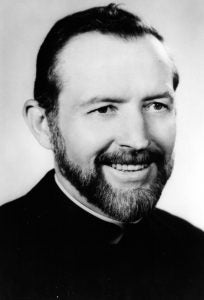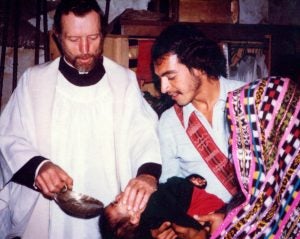“The shepherd cannot run at the first sign of danger.” These simple words held so much meaning in Father Stanley Rother’s letter to Oklahoma Catholics his last Christmas in 1980.
Despite his name being added to a death list in January 1981, the 5-foot-10, red-bearded, 46-year-old missionary knew he could not leave his parishioners behind during the Guatemalan Civil War. However, within days of returning to the Oklahoma Diocese’s mission in Santiago Atitlan, Father Stanley would pay the price.
On the morning of July 28, 1981, the beloved reverend’s life was taken when three ski-masked men broke into the mission rectory and executed him.
“I heard this from my parish priest in a homily earlier this year: ‘When we die, everything we did for ourselves is gone, but what we do for others will live on,’” said Patrick Rother, a nephew to the legendary padre. “This is why we are talking about Father Stan.”
And on Sept. 23, the world will be talking about Father Stan — the first U.S. born martyr to be beatified in the Roman Catholic Church — and his intense faith that all began on the family farm.

The oldest of four children born to Franz and Gertrud Rother, Stanley grew up on the family homestead a few miles west of Okarche, Oklahoma. Nestled on 560 acres, the Rothers grew winter wheat, oats, barley, and alfalfa, and raised 30-head of Angus cattle.
The young Rother was active in FFA and helping out on the farm — skills not often associated with being a priest as his nephew points out.
The Rother’s family life centered on God and they often prayed together as a family. During harvest, the family would invite the parish priest — who also grew up on a farm — out to help, especially with the alfalfa.
Growing up Stanley struggled with school work, specifically Latin, but didn’t give up because he told his family he felt called to be a priest. In fact, it took him two tries in seminary school before becoming ordained on May 25, 1963.
After serving five years in the Oklahoma Catholic community, Father Stanley received permission from the Bishop to join the Oklahoma Diocese’s mission in Santiago Atitlan, Guatemala – a place where the priest would soon learn his farming skills were desperately needed.
His parishioners included the native tribe of the Tzutuhil, decedents of the Mayans, whom Father Stan made every effort to connect with — learning both Spanish and the native Tzutuhil language, eating with them, visiting the sick, and aiding them with medical problems.

As a mission priest, Father Stan, or as the locals called him Padre Francisco, had to help fix broken trucks and work the fields. He built a farmers’ co-op, a school, a hospital, and the first Catholic radio station for the community.
“He basically rolled up his sleeves and got to work. There was an old bulldozer down there that he worked on and got running. He used it to clear boulders out of the fields. They crushed the rocks up so they could remove them,” recalls Tom Rother, Father Stanley’s brother. “When he returned to Oklahoma, he would take parts that he needed. He also disassembled a chisel and fertilizer spreader and hauled it down there in a truck.”
That hard work paid off for the priest’s parishioners. By clearing the land, using some fertilizer, and trying to grow different crops, Father Stanley was able to teach the poor Santiago Atitlan community how to grow food for their families.
“As farmers know, you need to be a jack of all trades and willing to do many things and work hard,” Patrick said. “Help those who need a helping hand — that personifies Father Stan’s life and ministry.”
After the beatification, that’s one thing Tom hopes people will remember most about his brother.
“How giving he was of himself — teaching them to be self-reliant and growing their own food,” Tom said.
As Patrick pointed out that giving attitude is why Father Stan is being recognized by the Catholic Church in the first place.
“He has touched a lot of lives in his short life,” Patrick said. “There are many ways to help others. Let us all follow Father Stan’s example.”



